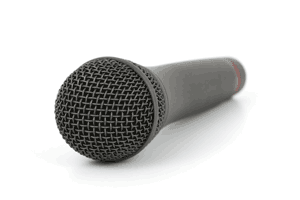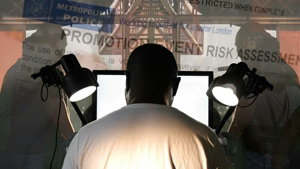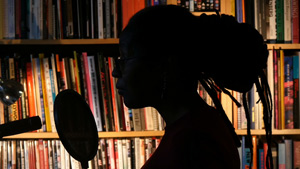‘Mic Drop I’ is a single screen video work featuring the poet Panya Banjoko. It was shown initially at the Beaconsfield Gallery Vauxhall (BGV) London in September-October 2017.
It takes as its starting point President Obama’s use of the ‘Mic-Drop’ in his final address to the White House Correspondents Dinner in April 2016 in order to engage in an critical examination of the deployment of the microphone as a conceptual device within black linguistic performative culture(s).
Ever since its early adoption within the club based rap battles of the 1980s, the Mic Drop has signalled the point at which the power of language to convey meaning has become saturated (reached it zenith) and only a definitive physical gesture (code) can carry sufficient ‘signifyin(g)’ power of closure.
In the 1987 rap ‘I Ain’t No Joke’, William Michael Griffin, aka ‘Rakim’ articulates his use of the gesture with characteristic clarity:
"I ain’t no joke
I used to make the mic smoke
Now I slam it when I’m done
And make sure it’s broke.
When I’m gone,
No one gets on
Cause I won’t let
Nobody press up and mess up
The scene I set"
Eric B & Rakim ‘I Ain’t No Joke’ 4th & B'Way(1987)
In this respect, the ‘mic drop’ becomes about the preservation of legacy. The creative labour embodied within a particular linguistic moment needs to be allowed contemplative distance.
The closure of the linguistic trail through the disabling of the microphone, therefore becomes a strategic act demanding that full attention is paid to what you have just witnessed. Nothing should be allowed, in the words of Rakim to "press up, and mess up, the scene I set''
Therefore in April 2016, when Barack Obama ended his final address to the White House Correspondents dinner with his gesturally knowing ‘Mic Drop’ accompanied by the words ‘Obama Out’, only in retrospect do we begin to recognise the symbolic significance of this moment. This theatrical severing of Obama’s oratory, with all of its linguistic flair, poetically colliding the professorial with the presidential, with the vernacular, was, unbeknown to us at the time, symbolic of a deeper and more pernicious severing of the advance of progressive and liberal ideas that had at long last delivered a Black US Presidency, and would in many minds go on to inevitably deliver a female one.
The recognition of these symbolic ramifications of the dropped mic, seems to have only more recently recognised by the Obama Foundation in their ‘Pass the Mic’ video of January 2017. Following the historic mic drop we witness the literal ‘end of the party’, the left over-debris of an aborted moment of celebration. A child slips into the room and picks her way through the residue to rescue the microphone abandoned on the floor. It is then that we leave her on the brink of uttering new words that we hope will re-engage the microphones progressive linguistic potential.
Obama Foundation. Pass the Mic
Directed by Morgan Neville. 2017
The grim wreckage of first ‘Brexit’ and then a Trump Presidency, underpinned as they both were by racial anxiety, were a signal that something fundamentally oppositional to assumed trajectories of social progress had resurfaced. There was truly to be no follow-up to Obama’s poetics (at least for this political generation). The microphone had been dropped, (‘broke’ within Rakim’s terminology). The rhetorical stream denoting a promise of liberal social progress becomes a thing of nostalgic memory, as the shrill, paranoid and intolerant language of a re-ascendant ‘alt right’ takes its place.
The tension between ‘dropping the mic’ and ‘passing the mic’ within radical political discourse then becomes an important one. The mic drop demotes termination, the end of discourse, whilst the passed mic denotes the handing over of linguistic and political power to peers, comrades or future generations.
What emerges from this is the identification of the microphone as a ‘gateway’ device.
If the microphone is dropped, the power to ‘voice’ is not in itself terminated. If the microphone is passed, the individual handing it over doesn’t loose the power of speech. However, the power for the voice to be transformed through the mechanism of the microphone, to be amplified, transmuted, transported, encoded, geographically and temporally shifted, is within the specific and exclusive gift of the microphone as a technological device.

What the work ‘Mic Drop’ attempts to explore therefore is not just the theatrics and implications of the April 2016 Obama mic-drop moment, but the potential empowerment of human linguistic ‘labour’ through its relationship with the microphone as a ‘tele’ enabling device. It is a device that endows the power to ‘voice’ over distance through a sequence of encoding/ transmission/ decoding protocols. I would argue that this enabling technology has been of particular significance to diasporic or scattered peoples in its ability to reconnect severed linguistic connections and to rearticulate disconnected knowledge systems across geographic space (in itself a decolonizing act).
In the work ‘Mic Drop’ this relationship is alluded to as being an example of a ‘non conjoined cyborg’, where the human body and technology are temporally conjoined to create an enhanced entity capable of projecting power beyond the norm. (it is this enhanced capability makes the ‘cyborg’ potentially ‘monstrous’ within a range of science fiction texts).
Within black popular culture, one of the spaces in which this potentially ‘monstrous’ techno empowered entity emerges is in the guise of the ‘MC’ (derived from the term ‘master of ceremonies) within the multiple traditions of dance-hall culture. The MC (as opposed to the DJ) is empowered to use the normally intimate/local device of the voice/spoken word to engage with, and enhance the mood of the crowd at a social event through the amplifying device of the microphone. The core role of the ‘master of ceremonies’ to propose ‘toasts’ at a social/festive event, evolved into the tradition of ‘toasting’ within Jamaican dancehall culture, and would subsequently export via the USA globally in the form of ‘rapping’.

Within these dancehall traditions, and the multiple others that have been subsequently generated, the microphone has allowed the human voice of the MC/rapper/toaster to ‘ride’ the amplified sonic mix, beats and sounds of the dancehall or club. The power of the microphone enabled MC therefore to set and orchestrate the social mood, to introduce content and to set and stimulate the atmosphere and agenda within these events is evident by their ‘star status’. The social, political, and potentially moral (or immoral) authority of the MC to ‘move the crowd’ is recognized by the state, arguably in devices such as the infamous ‘Form 696’ used by the Metropolitan Police to specifically target club events that ‘predominantly features DJs or MCs performing to a recorded backing track…’. By specifically positing the space of contemporary dancehall/club culture as a site of special ‘risk’ (within the formalized language of ‘risk assessment’), the notion of the black voice empowered by technology representing a thing of danger is literally written into law.
This nexus of the black body (as exemplified by it’s linguistic/vocal signature) in combination with the empowering technology of the microphone creates an entity whose power/danger/monstrous potential (as non conjoined cyborg) is both recognised and demonized within contemporary discourse. The acts of dropping, passing or picking up the microphone are all in their turn charged, symbolic and political, and form the thematic core of this work.
